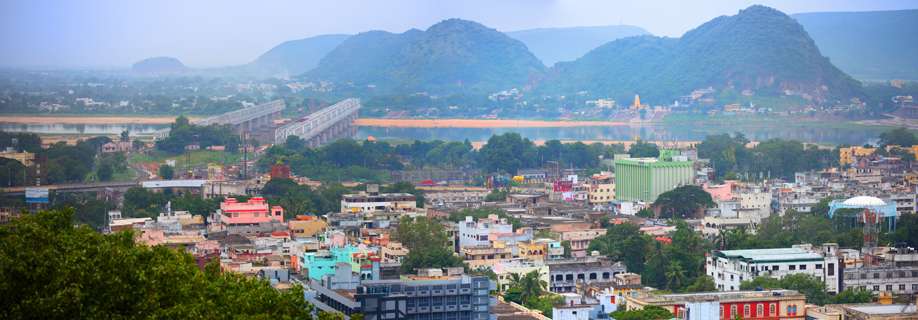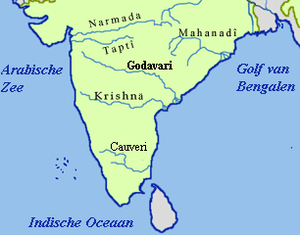Vijayawada
| Vijayawada | |
|---|---|
| Metropolis | |
 Clockwise from top left: VMC pylon, Krishnaveni statue, Deccan Queen, Krishna River and Prakasam Barrage, police control room junction, Kanaka Durga Temple and Telugu Thalli statue | |
| Etymology: Vijaya | |
| Nickname(s): Bezawada | |
 Vijayawada Location of Vijayawada  Vijayawada Vijayawada (India) | |
| Coordinates: 16°31′09″N 80°37′50″E / 16.5193°N 80.6305°ECoordinates: 16°31′09″N 80°37′50″E / 16.5193°N 80.6305°E | |
| Country | India |
| State | Andhra Pradesh |
| District | Krishna |
| Region | Coastal Andhra |
| Incorporated (Municipality) | 1 April 1888 |
| Incorporated (Corporation) | 1981 |
| Founded by | Arjuna |
| Named for | Victory |
| Government | |
| • Type | Mayor–Council |
| • Body | Vijayawada Municipal Corporation |
| • Mayor | Koneru Sridhar (Telugu Desam Party) |
| • MLAs |
List of MLAs
|
| • MP | Kesineni Srinivas |
| • Municipal commissioner | J. Nivas |
| Area[1] | |
| • Metropolis | 61.88 km2 (23.89 sq mi) |
| • Metro[2] | 437.09 km2 (168.76 sq mi) |
| Area rank | 2nd (in state) |
| Elevation[3] | 23 m (75 ft) |
| Population (2011)[4] | |
| • Metropolis | 1,034,358 |
| • Rank |
27th (India) 2nd (Andhra Pradesh) |
| • Density | 31,289/km2 (81,040/sq mi) |
| • Metro[2] | 1,800,000 |
| Demonym(s) | vijayawadian |
| Time zone | UTC+5:30 (IST) |
| PIN | 520 XXX |
| Telephone code | +91-0866 |
| Vehicle registration | AP-16, AP-17, AP-18, AP-19 |
| Official language | Telugu |
| Website |
vijayawada |
Vijayawada is a city in the Andhra Pradesh Capital Region, on the banks of River Krishna in Krishna district of the Indian state of Andhra Pradesh.[5][6][7] The city is the third most densely populated in the urban population of built-up areas in the world and is the second largest city in Andhra Pradesh by population.[8] Vijayawada is classified as a Y-grade city as per the Sixth Central Pay Commission.[9] Vijayawada is the commercial headquarters of Andhra Pradesh. It was recognised as a "Global City of the Future" by McKinsey Quarterly, which expected an increase to GDP of $17 billion by 2025.[10][11] Vijayawada was ISO 37120 Platinum Level certified in October 2018 and has been added to the "Global Cities Registry".[12][13]
The city is known for its landmarks such as Prakasham Barrage across the Krishna river;[14] Krishnaveni Mandapam (River Museum) depicting the history of Krishna river and a nearby idol of the river known as Krishnaveni statue; Gandhi Hill, the first Mahatma Gandhi Memorial in the country, an elevation of 500 ft on the on a hill; Bhavani Island, one of the largest river island amidst Krishna River. The Kanaka Durga Temple is a Hindu temple of Goddess Durga on the Indrakeeladri hill, on the banks of Krishna River. The deity is described as Swayambhu (self-manifested) in Triteeya kalpa.[15] Akkana Madanna cave temple is a rock-cut temple which is located at the lower reach of the Indrakeeladri temple[16].
Toponomy
There are many legends behind the origin of the name Vijayawada. Goddess Durga killed the demon and relaxed in this place for some time. As she was victorious (vijaya), the place came to be known as Vijayawada (vijaya translates to victory and wada as place/location, literally "The Place of Victory").[17]
The epic Mahabharata refers to the Indrakiladri hills as the place where Arjuna secured Pashupatastra from Lord Shiva. The city thereafter came to be known as Vijayavatika and later as Vijayawada.[18]
In some legends, Vijayawada was referred to as 'Rajendracholapura'. A tale behind its acquiring the name Bezawada is that Goddess Krishnaveni (River Krishna) requested Arjuna to make a passage for her to merge into the Bay of Bengal. Hence, Arjuna made a bejjam (hole) through the mountains and the place came to be known as Bejjamwada which later changed to Bezawada.[19][20][21]
There is a rational reason behind the name change. At that time the Odisha Gajapatis kings ruled this area, they wrote and pronounced Vijayawada as Bizayawada, because the Odia people used the letter 'B' instead of V. Then at the time of British rule, the Bengali scholars who helped the British rulers in the ruling, wrote and pronounced Vijayawada as Bizayawada. Gradually Bizayawada became Bizawada and Bezawada in Britishers calling.[22]
Brief history
Bezawada(as Vijayawada was known then) was founded around 626 A.D. by Paricchedi Kings(ancestors of Pusapati Kings of Vizianagaram).[23]
Vijayawada history reveals that Bezawada (Vijayawada) was ruled by King Madhava Varma (one of the kings of Vishnukundina dynasty).[24] Chinese Buddhist scholar Xuanzang stayed few years in Bezawada (Vijayawada) in around 640 A.D. to copy and study the Abhidhamma Pitaka, the last of the three pitakas (Pali for baskets) constituting the Pali canon, the scriptures of Theravada Buddhism.[25]
Mogalrajapuram hills have five rock-cut temples, built during the 4th–9th centuries. Some of the caves can be attributed to Vishnukundina dynasty. Akkana Madanna Caves, at the foot of Indrakeeladri Hill, is a monument of national importance.[26]
At the foot of Indrakeeladri hills is the temple of Malleswara. The temple has inscriptions dating back to 9th century AD to 16th century AD by various kings. There are ten pillars and a mutilated slab (recognised as monuments by Archaeological Survey of India) with inscriptions in the Telugu language. Of them, the inscriptions issued by Yudhamalla I and II of Eastern Chalukyas are important.[26]
In the early 16th century, during the reign of Qutb Shahi dynasty (also known as Golconda Sultanate), diamond mines were found near Vijayawada on the banks of Krishna River.[27]
Geography
Vijayawada lies on the banks of Krishna River,[28] covered by hills and canals.[8] It is 18.5 km (11.5 mi) from the state capital, Amaravati.[29] and at an altitude of 11 m (36 ft) above sea level.[3] Three canals originating from the north side of the Prakasham barrage reservoir — Eluru, Bandar, and Ryves — flow through the city.[30]
Climate
Vijayawada has a tropical climate (Köppen Aw).[31] The annual mean temperatures range between 23.4–34 °C (74–93 °F); with the maximum temperatures often crosses 40 °C (104 °F) in the month of May and the minimum in December and January.[32] The highest maximum temperature ever recorded was 48.8 °C (119.8 °F) in May 2002, and the lowest was 12.4 °C (54 °F) on January 1997. May is the hottest and January is the coldest month of the year.[32].[33] It receives rainfall from the South-west and North-east monsoons[31] and the average annual rainfall recorded is 977.9 mm (38.50 in).[32]
| Climate data for Vijayawada (1981–2010) | |||||||||||||
|---|---|---|---|---|---|---|---|---|---|---|---|---|---|
| Month | Jan | Feb | Mar | Apr | May | Jun | Jul | Aug | Sep | Oct | Nov | Dec | Year |
| Average high °C (°F) | 30.2 (86.4) |
32.9 (91.2) |
35.7 (96.3) |
37.9 (100.2) |
40.0 (104) |
37.6 (99.7) |
33.9 (93) |
32.8 (91) |
33.1 (91.6) |
32.1 (89.8) |
31.2 (88.2) |
30.2 (86.4) |
34.0 (93.2) |
| Average low °C (°F) | 18.6 (65.5) |
20.3 (68.5) |
22.7 (72.9) |
25.4 (77.7) |
27.2 (81) |
27.0 (80.6) |
25.4 (77.7) |
25.1 (77.2) |
24.9 (76.8) |
23.7 (74.7) |
21.2 (70.2) |
18.9 (66) |
23.4 (74.1) |
| Average precipitation mm (inches) | 1 (0.04) |
4 (0.16) |
5 (0.2) |
15 (0.59) |
71 (2.8) |
136 (5.35) |
250 (9.84) |
197 (7.76) |
164 (6.46) |
169 (6.65) |
45 (1.77) |
10 (0.39) |
1,067 (42.01) |
| Average precipitation days | 0.5 | 0.5 | 0.9 | 0.8 | 2.5 | 6.8 | 12.1 | 10.5 | 8.8 | 7.7 | 2.5 | 0.8 | 54.5 |
| Source #1: India Meteorological Department[32] | |||||||||||||
| Source #2: Climate-Data.org[34] | |||||||||||||
Demographics
| Vijayawada population | |||
|---|---|---|---|
| Census | Pop. | %± | |
| 1871 | 8,206 | — | |
| 1881 | 9,366 | 14.1% | |
| 1891 | 20,224 | 115.9% | |
| 1901 | 24,224 | 19.8% | |
| 1911 | 32,867 | 35.7% | |
| 1921 | 44,159 | 34.4% | |
| 1931 | 60,427 | 36.8% | |
| 1941 | 86,184 | 42.6% | |
| 1951 | 161,198 | 87.0% | |
| 1961 | 234,360 | 45.4% | |
| 1971 | 344,607 | 47.0% | |
| 1981 | 543,008 | 57.6% | |
| 1991 | 701,827 | 29.2% | |
| 2001 | 845,217 | 20.4% | |
| 2011 | 1,476,931 | 74.7% | |
As of 2011 Census of India, the city had a population of 1,476,931. The total population constituted 524,918 males and 523,322 females — for a sex ratio of 997 females per 1000 males — higher than the national average of 940 per 1000.[38] 92,848 children were in the age group of 0–6 years, of which 47,582 were boys and 45,266 were girls: a ratio of 951 per 1000. The average literacy rate stood at 82.59% (male 86.25%; female 78.94%) with 789,038 literates, significantly higher than the national average of 73.00%.[4][39] Vijayawada is one of the most densely populated cities with approximately 31,200 people per square km.
Language and religion
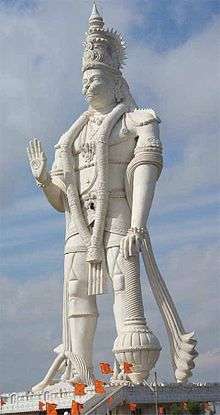
The predominant language spoken by the city residents is Telugu.[41]
Governance
Civic administration
Vijayawada Municipal Corporation is the civic governing body of the city and was the first ISO 9001 certified urban local body in the country.[42]
It was constituted on 1 April 1888 and was upgraded to selection grade municipality in 1960, and, to the corporation in 1981. The jurisdictional area of the corporation is spread over an area of 61.8 km2 (23.9 sq mi) with 59 wards.[43] The present municipal commissioner of the city is J. Nivas[44] and the present mayor is Koneru Sridhar.[45] Vijayawada is the headquarters of Andhra Pradesh Capital Region Development Authority.[46]
As per the G.O. 104 (dated:23-03-2017), the state government had declared Vijayawada Municipal Corporation and its contiguous areas as a metropolitan area of Vijayawada.[47] Its jurisdiction is spread over an area of 160 km2 (62 sq mi) and has an estimated population of 18 lakhs.[48] The metropolitan area covers Vijayawada municipal corporation and merged villages of Ambapuram, Buddavaram, Done Atkuru, Enikepadu, Ganguru, Gannavaram, Gollapudi,[2] Gudavalli, Jakkampudi, Kanuru, Kesarapalle, Nidamanuru, Nunna, Pathapadu, Penamaluru, Phiryadi Nainavaram, Poranki, Prasadampadu, Ramavarappadu, Tadigadapa, and Yanamalakuduru.[49] The urban agglomeration spread in Guntur district covers Tadepalle Municipality and its outgrowth of Undavalli; Mangalagiri Municipality and its outgrowths of Navuluru and Atmakur.[50]
Utility services
Water supply from the 59 water reservoirs, maintenance of roads, sewerage, underground drainage, environment protection programs, recycling of solid waste and producing power are the services are provided by the Vijayawada Municipal Corporation.[51] There has been an underground drainage system in the city since 1967–68. Many green parks are maintained by the corporation to protect the environment such as Raghavaiah park, Rajiv Gandhi Park, Dr. B.R Ambedkar Park, Mahatma Gandhi Park etc.[52] The corporation won many awards and achievements such as National Urban Water Award (2009), Siti e-Governance Project, ISO 9001 certification for Quality Management System.[1]
The Andhra Pradesh State Disaster and Fire Response Department with its headquarters in the city[53] are responsible for protecting from fire accidents that occur during summers on the hill slope areas of the city.[54]
Pollution control
Vijayawada is one of the cities to be covered under the Solar/Green Cities scheme launched by the Ministry of New and Renewable Energy and is one of the 15 cities in the country listed in Pilot Solar Cities.[55] The city is promoting the use of environmentally friendly transport supported by biodiesel,[56] CNG in auto rickshaws[57] and electric 'E-rickshaws'[58] were introduced.
Law and order
The Vijayawada City Police has its own Police Commissionerate, which is responsible for an area of 1211.16 sq.km.,[59] is headed by a Police Commissioner, who is an Indian Police Service officer of Additional Director General of Police rank along with one joint commissioner of police and four Deputy Commissioners of Police who are also IPS officers. The present Police commissioner is Goutham Savangh.[60]
Economy

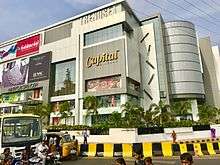
Vijayawada is one of the rapidly growing urban markets of the country.[61] The sectors that contribute to the city economy are construction, education, entertainment, food processing, hospitality, registrations, transport, etc.[62] Based on the recommendations of the Sixth Central Pay Commission, it is classified as one of the Y-grade cities of India.[9] The GDP of Vijayawada in 2010 was $3 billion and is estimated to touch $17 billion by 2025.[63]
Andhra Cements (1937) was the first cement factory in Andhra Pradesh. Siris Pharmaceuticals was the first pharma company in Andhra Pradesh and was established in 1950.
The city has trading and exporting markets for agriculture and industrial goods.[63] The Nunna Mango Market is one of the largest mango markets in Asia, exporting to major cities in the country.[64] It is also a hub for storage, bottling, and transportation of petroleum products of all major companies like BPCL, HPCL, and IOC.[65]
The growing population and economy have resulted in rising real estate prices.[66]
Culture

The city is known in the state for its cultural history,[67] whose residents are more often referred to as 'Vijayawadian'.[68] There are many religions, languages, traditions, and festivals.[69][70] Durga Pooja and a special Theppotsavam in Krishna river are important events of the Hindu festival of Dussera in the city, mainly due to the existence of self-manifested Kanaka Durga Temple.[71] Hazarat Bal Mosque is a Muslim shrine housing the holy relic of the Prophet Mohammed.[72] The Gunadala Mary Matha Church is an important shrine for Christians and illuminates during Christmas Eve.[73]
The city corporation organizes "Happy Sunday," an event organized on the first Sunday of every month at M.G. Road for promoting activities such as sports, games, cultural events, and yoga.[74] The clothing of the locals includes traditional men wearing dhoti and women wearing saree and salwar kameez. Western clothing is also predominant.[75]
Arts, crafts and artefacts
The Vijayawada Art Society promotes Telugu arts.[76] The city hosted Poetic Prism 2015, a multilingual poet's meet on September 19, 2015.[70] All these activities are organized in collaboration with the Cultural Centre of Vijayawada. Kondapalli Toys — which were granted geographical indication in 2007[77] — are handmade by the artisans of Kondapalli, a suburb of Vijayawada.[78] Victoria Jubilee Museum is an archaeological museum in the city, which houses sculptures, paintings, and artifacts of Buddhist and Hindu relics, dating back to the 2nd and 3rd centuries.
Cityscape
The city of Vijayawada has old and new town areas. The One Town area of the city is known as old city area, comprising areas such as Islampeta, Jendachettu Centre, Kamsalipeta, Rajarajeswaripeta, Kothapeta, Ajithsinghnagaram, and Winchipeta.[79] The new city areas include areas such as Autonagar, Benz circle, Chuttugunta, Labbipeta, Machavaram Down, Mogalrajapuram, NTR circle, Tikkle Road, Governorpeta, Pinnamaneni Polyclinic Road and Suryaraopet.[79][80][81]
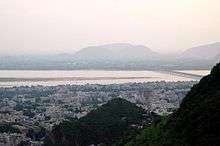
Brindavan Colony, Commercial Taxes Colony, Gunadala, Veterinary Colony are some of the residential areas.[80] Bank Colony, Bharati Nagar, Currency Nagar, Satyanarayana Puram, Gurunanak Colony, LIC Colony, Patamata and MG Road are the upscale residential areas.[82][83] The major commercial areas include the stretch of MG Road and from Benz Circle to Ramavarappadu Ring.[80][83] Other commercial centers are Besant Road, Rajagopalachari street, One Town market area covering Kaleswara Rao Market, and Vastralatha.[84][85][86]
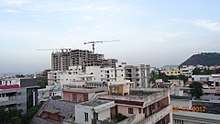
Transport
Road
The primary modes of intra-city public transport are city buses and auto rickshaws.[87] Apart from these, other means of transport are motorcycles, cycle rickshaws, and bicycles.[87]:37,44 The Pandit Nehru Bus Station and the Vijayawada railway station are the major transport infrastructure in the city for road and rail transport.[88] Besides those two there are other modes of transport infrastructures i.e., Autonagar bus terminal and city bus port. Another nearest railway station to Vijayawada is Krishna canal Jn. The Pandit Nehru bus station is the administrative headquarters of APSRTC,[89] which is ranked as the fourth largest and busiest bus terminals in the country.[90] The Vijayawada City Division of APSRTC operates close to 450 buses for an average of 300,000 daily commuting passengers[91] and is supported by BRTS corridors.[92] The two major National Highways of NH16(Old NH5) connecting Kolkata–Chennai and NH-65 (previously designated as NH-9) connecting Pune–Hyderabad-Suryapet-Machilipatnam provides access to other states.[93][94] National Highway 30 from Jagdalpur of Chhattisgarh terminates near the city suburb of Ibrahimpatnam.[94] The Inner Ring Road connects NH 16 and 65 to serve the main purpose of easing traffic congestion.[95]
The city has a total road length of 1,264.24 km (785.56 mi), covering 1,230.00 km (764.29 mi) of municipal roads, 22.74 km (14.13 mi) of R&B (Roads & Buildings) department roads, 11.50 km (7.15 mi) of National Highways.[96] M.G. Road and Eluru road are the main arterial roads of the city.[97] Benz Circle is one of the busiest road junctions in the city with an average of 57,000 vehicles crossing daily, The junction has the intersection of two national highways of NH 16 and NH 65.[98]
Rail
Vijayawada railway station is classified as an A1 category station[99] and is one of the busiest of Indian Railways.[100] Suburban rail services are operated from the railway station to the nearby cities of Guntur and Tenali, Gudivada, machlipatnam, Bhimavaram, Narasapuram.[101][102] The city houses the headquarters of Vijayawada railway division, one of the six railway divisions of South Central Railway zone.[103] The station has also a diesel and electric loco sheds which have a capacity of holding 220 locos by both the sheds. Also, this station connects to the major cities of India such as Mumbai, Secunderabad, Chennai, Delhi and Howrah by train. This is also a junction for Howrah-Chennai, Howrah-Banglore and Delhi-Chennai main lines. This city has also the satellite stations to serve the city in busy times such as Krishna canal Jn. etc.
A new circular railway project proposed would extend up to the state capital, Amaravati.[104][105] The Vijayawada Metro is a planned rapid transit system that would be constructed in two corridors.[106]
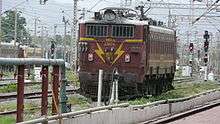
The city of Vijayawada has several satellite stations such as, Gannavaram, Gunadala, Krishna Canal, Ramavarappadu,[107] Kondapalli, Rayanapadu,[108] Madhura Nagar,[109] Nidamanuru[110]
Suburban and high speed rail
A proposed circular train connectivity would connect Vijayawada with neighbouring cities of Guntur, Tenali, Mangalagiri and the state capital, Amaravati.[111][112].
Waterways
The seamless commuting in the city is supported by the presence of 16 bridges across the three canals of Bandar, Eluru, and Ryves.[113] M G Road and Eluru Road are the major arterial roads of the city,[114] with as many as 90,000 vehicles plying M.G. Road (Bandar Road) itself.[115] The city has a total road length of 1,264.24 km (785.56 mi),[116] used by 678,004 non-transport and 94,937 transport vehicles.[117] The heavy vehicles like lorries are used for freight transport and hold a share of 18% in the country.[118] Short distance commuting is served by 27,296 auto rickshaws plying the city roads every day,[117] which include the women-driven 'She Autos'.[119]
Air
The Vijayawada Airport at Gannavaram provides air connectivity to major metropolitan cities of the country.[120] On 3 May 2017, Vijayawada Airport was upgraded from domestic to international.[120] During the 2016–17 fiscal year, it registered domestic passenger movement growth rate of 56.1% with a total passenger count of 622,354[121] and aircraft movement recorded a growth of 54.8% with 10,333 aircraft.[122]
Education

The primary and secondary school education is imparted by the government, aided and private schools, under the state School Education Department.[123][124] As per the school information report for the academic year 2015–16, the city limits have 133,837 students enrolled in 529 schools.[125] The state and CBSE syllabus are followed by schools for the Secondary School Certificate.[126][127] The languages of instruction are English, Telugu, and Urdu.[128]
For 10+2 education, there are two government junior colleges, namely, SRR and CVR Government Junior College and Government Junior College (at Vinchipeta); a Railway Junior college; three co-operative, 12 private aided, including the oldest, S.R.R & C.V.R College (established in 1937), Andhra Loyola College (established in December 1953), Maria Stella College for Girls (established in 1962); V.R Siddhartha Engineering College (established in 1977) the oldest Engineering College in Andhra Pradesh, and many private unaided colleges.[129] School of Planning and Architecture, Vijayawada (SPAV) was established in 2008, a higher education institute in Vijayawada. It is one of the three Schools of Planning and Architecture (SPAs) established by the Ministry of Human Resource Development in 2008 as an autonomous institute and a full central funded institution.
The Sarvotthama Grandhalaya is a city library established on 30 March 1987. It serves an average daily readership of 200, equipped with 22,000 books related to many fields.[130] VMC & VBFS Research and Reference Library is a reader's room/library maintained by Vijayawada Book Festival Society.[131]
Media
Visalaandhra was the first newspaper in the state, started from Vijayawada.[132] As per the 58th annual report of Press India 2013–14, the large and medium Telugu daily publications from Vijayawada include Andhra Jyothy, Eenadu, Sakshi, Suryaa, Andhra Prabha, Telugu Jatiya Dinapatrika Vaartha, Praja Sakti, and Udaya Bharatam. The English publications are Deccan Chronicle, The Hindu, The Times of India, News Boom, The Fourth Voice, and Views Observer.[133]
The All India Radio Vijayawada was commissioned on 1 December 1948.[134] Its building was named after Pingali Venkaiah, the designer of the Indian flag.[135] The channels broadcast by All India Radio are Rainbow Krishnaveni FM,[135][136] Vividh Bharati.[137] Telugu Doordarshan saptagiri is located here.
Sports

Indira Gandhi Stadium in the city is the headquarters of the Sports Authority of Andhra Pradesh.[138] It has hosted the only Men's ODI on 24 November 2002, played between India and West Indies.[139]
The only women's ODI was hosted on 12 December 1997, played as a group match of 1997 Women's Cricket World Cup between England women's and Pakistan women's teams.[140] Makineni Basavapunnaiah Stadium at Ajit Singh Nagar is another stadium that caters the sporting needs of the northern part of the city.[141] Indoor stadiums include Dandamudi Rajagopala Rao Indoor Stadium (DRRIS) at M.G.Road and Chennupati Ramakotaiah Indoor Stadium (CRIS) at Patamatalanka. The DRRIS was named after the former weightlifter, Dandamudi Rajagopala Rao, who participated in the 1951 Asian Games and the 1956 Olympics.[142] The DRRIS hosted several national and international sporting events, such as the 79th Senior Badminton Champions.[143]
Spoorthy is the first paddler from the city to have represented at international level.[144] Andhra Cricket Association(ACA) International Cricket Stadium is being built on a 30-acre (12 ha) site at Novlur Village, Mangalagiri Mandal of Guntur district, t 15 km from the city of Vijayawada. It will serve as the Andhra Cricket Association stadium.[145] Vijaya Madhavi Tennis Academy is in Loyola College; Loyola College Grounds hosted many national-level events which includes a Ranji match.[146]
The railway sports stadium, near the railway station, hosted several national level railway and a few non-railway events. This stadium has a gallery facility of over 10,000 people. Makineni Basava Punnaiah stadium is another open stadium in the city. Dandamudi Raja Gopal Rao indoor stadium is one of the noted badminton stadiums in AP. It hosted several national level badminton and table tennis championships.[147][148]
The city has been confirmed for the 6th round of the 2018 F1H2O World Championship: UIM F1H2O Amaravati Grand Prix that will be held on 16,17,18 November 2018 in the Krishna river.[149]
See also
References
- 1 2 "Vijayawada: A Profile" (PDF). Vijayawada Municipal Corporation. p. 1. Retrieved 11 December 2015.
- 1 2 3 "Govt Declares Vijayawada A Metropolitan City". Primepost.in. 25 March 2017. Retrieved 29 May 2017.
- 1 2 "Maps, Weather, and Airports for Vijayawada, India". fallingrain.com.
- 1 2 "Vijayawada City Population Census 2011 | Andhra Pradesh". www.census2011.co.in. Retrieved 19 April 2017.
- ↑ SASIKUMAR, K.; KRISHNA, SANOOP GOPI (2009). Solid Waste Management. PHI Learning Pvt. Ltd. p. 267. ISBN 9788120338692. Retrieved 9 June 2017.
- ↑ "Welcome to Krishna District". krishna.nic.in. Retrieved 10 June 2017.
- ↑ "Urban Footprints in APCRDA Region". APCRDA. Retrieved 10 June 2017.
- 1 2 "Vijayawada is third densely packed city; 31,200 people in every square km". Retrieved 2016-08-25.
- 1 2 "Sixth Central Pay Commission Classification of Cities" (PDF). Ministry of Personnel, Public Grievances and Pension. Retrieved 26 March 2014.
- ↑ Raghavendra, V. "A fillip for "McKinsey's global city"". The Hindu. Retrieved 13 June 2017.
- ↑ "Economy of the City" (PDF). City Development Initiative For Asia. Retrieved 31 July 2014.
- ↑ Boda, Tharun (2018-10-05). "City gets ISO 37120 certification, enters Global Cities Registry". The Hindu. ISSN 0971-751X. Retrieved 2018-10-07.
- ↑ "Global Cities Registry™". World Council on City Data. Retrieved 2018-10-07.
- ↑ "PRAKASAM BARRAGE". irrigation.cgg.gov.in. Retrieved 7 May 2016.
- ↑ http://www.acharyaonline.com/kanakadurga.htm
- ↑ "Centrally Protected Monuments". Archeological Survey of India. Retrieved 27 May 2017.
- ↑ Ross (1988). Corporate Finance 8E. Tata McGraw-Hill Education. p. 272. ISBN 978-0-07-009124-5. Retrieved 30 March 2016.
- ↑ "Vijayawada Region". AP Tourism. Government of Andhra Pradesh. Retrieved 13 July 2015.
- ↑ Ayyar, P. V. Jagadisa (1993). South Indian Shrines (Rev. and enl. ed.). New Delhi [u.a.]: Asian Educational Services. ISBN 81-206-0151-3. Retrieved 4 August 2014.
- ↑ Reddy, V.V. Subba (2009). Temples of South India. New Delhi: Gyan Pub. House. p. 80. ISBN 978-81-212-1022-5. Retrieved 7 June 2015.
- ↑ "Tunnel road lives up to name Bezawada". Deccan Chronicle. 11 November 2015. Retrieved 10 June 2017.
- ↑ Voice, Amaravati. "History of Vijayawada – Explore The City Of Victory". www.amaravativoice.com. Retrieved 2018-09-23.
- ↑ Krishnamurty, Salva; Hikosaka, Shu; Samuel, G. John (14 August 1994). "A History of Telugu Literature". Inst. of Asian Studies – via Google Books.
- ↑ Sculptures in a cavern at Bezawara [Vijayawada] supposed to belong to the Jain Religion. 21 August 1815, retrieved 2 September 2013
- ↑ "Xuan Zang stayed in Vijayawada to study Buddhist scriptures".
- 1 2 "Monuments of ASI under Hyderabad Circle".
- ↑ P., Raghunadha Rao, (1997). History and culture of Andhra Pradesh : from the earliest times to the present day. Sterling Publishers. ISBN 9788120717190. OCLC 46680300.
- ↑ "With love, from Venice to Vijayawada". The Hindu. Retrieved 8 June 2017.
- ↑ "Vijayawada, Amaravati twin cities". Deccan Chronicle. 25 July 2015. Retrieved 8 June 2017.
- ↑ "Canal bunds hot beds for growth of slums spotlight". The Hindu. Retrieved 21 April 2017.
- 1 2 "Vijayawada City Disaster Management Plan – 2015" (PDF). Disaster Management. p. 6. Retrieved 9 June 2017.
- 1 2 3 4 "Vijayawada Climatological Table Period: 1981–2010". India Meteorological Department. Retrieved 27 May 2015.
- ↑ "Vijayawada weather". Deccan Chronicle. 4 June 2014. Retrieved 25 June 2014.
- ↑ "Climate: vijayawada". Retrieved 19 February 2016.
- ↑ Rao, Kondapalli Ranga; 1. Rao, M. S. A. (1984). Cities and Slums: A study of a Squatters' Settlement in the City of Vijayawada. Concept Publishing Company. p. 12.
- ↑ "Demography, Economy and Land Use" (PDF). Vijayawada Municipal Corporation. p. 7. Retrieved 13 June 2017.
- ↑ "Provisional Population Totals, Census of India 2011: Urban Agglomerations/Cities having population 1 lakh and above" (PDF). Office of the Registrar General & Census Commissioner, India. Retrieved 9 July 2018.
- ↑ "Sex Ratio". The Registrar General & Census Commissioner, India. Retrieved 2 September 2014.
- ↑ "Chapter–3 (Literates and Literacy rate)" (PDF). Registrar General and Census Commissioner of India. Retrieved 2 September 2014.
- ↑ "Vijayawada Religion 2011". www.census2011.co.in. Retrieved 14 June 2017.
- ↑ "The Hindu : Andhra Pradesh / Vijayawada News : Championing the cause of Telugu language". The Hindu. Retrieved 14 June 2017.
- ↑ Bhatnagar, Subhash (2009-03-01). Unlocking E-Government Potential: Concepts, Cases and Practical Insights. SAGE Publications India. p. 195. ISBN 9788132102489. Retrieved 9 May 2017.
- ↑ "Vijayawada Municipal Corporation". Ourvmc.org. Retrieved 30 January 2012.
- ↑ "Commissioner's Profile". Vijayawada Municipal Corporation. Retrieved 19 May 2018.
- ↑ "Workshop on fertilizers today". The Hindu. Vijayawada. 8 February 2016. Retrieved 14 February 2016.
- ↑ Special Correspondent. "AP Capital Region Development Authority comes into being". The Hindu.
- ↑ "Welcome to Government Order Issue Register". goir.ap.gov.in. Retrieved 27 March 2017.
- ↑ "Govt Declares Vijayawada A Metropolitan City". Primepost.in. 25 March 2017. Retrieved 30 May 2017.
- ↑ Reporter, Staff. "Vijayawada, 19 other contiguous areas notified as Metropolitan Area". The Hindu. Retrieved 27 March 2017.
- ↑ "Name of Urban Agglomeration and its State constituent Units-2011" (PDF). Census of India. p. 11,22–23. Retrieved 21 September 2015.
- ↑ "About VMC". Vijayawada Municipal Corporation. Retrieved 30 May 2017.
- ↑ "Parks in Vijayawada". ourvmc. Retrieved 27 June 2014.
- ↑ RAGHAVENDRA, V. "Fire HQ at Vijayawada to open in Nov". The Hindu. Retrieved 31 May 2017.
- ↑ "3.5 lakh people in Vijayawada vulnerable to fire mishaps". The New Indian Express. Retrieved 31 May 2017.
- ↑ "Mahabubnagar, Vijayawada to be developed as 'Solar Cities'". The Hindu. Hyderabad. 24 August 2015. Retrieved 21 September 2015.
- ↑ Sandeep Kumar, S (11 August 2015). "Biodiesel launched in Vijayawada, Vizag". The Hindu. Vijayawada/Visakhapatnam. Retrieved 21 September 2015.
- ↑ "CNG scarcity hits livelihood of auto drivers". The Hans India. Retrieved 27 May 2017.
- ↑ Varma, P. Sujatha. "E-rickshaw hits Vijayawada roads". The Hindu. Retrieved 4 May 2017.
- ↑ "About City Police".
- ↑ "Kin of home guards receive cheques". The Hans India. Retrieved 31 May 2017.
- ↑ "The rapidly growing, stable markets of southern India – Livemint". www.livemint.com. Retrieved 31 May 2017.
- ↑ "Vijayawada, a growth engine for Andhra Pradesh economy". Deccan Chronicle. 28 May 2016. Retrieved 3 April 2017.
- 1 2 "Economy of the City" (PDF). Cities Development Initiative for Asia. City Development Initiative For Asia. p. 2. Archived from the original (PDF) on 17 July 2014. Retrieved 31 May 2017.
- ↑ Rao, G. Venkataramana. "Asia's biggest mango market loses sheen". The Hindu. Retrieved 31 May 2017.
- ↑ "Industrial Scenario" (PDF). apind.gov.in. p. 10. Retrieved 25 June 2015.
- ↑ "Despite slowdown, housing prices bullish across cities". The Economic Times. 31 August 2012. Retrieved 31 May 2017.
- ↑ Laveesh, Bhandari (2009). Indian States at a Glance 2008-09: Performance, Facts and Figures – Andhra Pradesh. Pearson Education India. p. 23. ISBN 9788131723319.
- ↑ "It's New Year revelry all over". The Hindu. Retrieved 14 June 2017.
- ↑ "Vijayawada to get a Cultural centre". Deccan Chronicle. Hyderabad. 21 January 2015. Retrieved 21 September 2015.
- 1 2 "Vijayawada to host Poetic Prism-2015". The Hindu. Vijayawada. 19 September 2015. Retrieved 21 September 2015.
- ↑ "Dussehra festivities end, but joy continues at Vijayawada KanakaDurga temple". Deccan Chronicle. Vijayawada. 5 October 2014. Retrieved 21 September 2015.
- ↑ "::.AP TOURISM.::". www.aptdc.gov.in. Retrieved 3 April 2017.
- ↑ "Vijayawada decked up for Christmas celebrations". The Hans India. Retrieved 3 April 2017.
- ↑ Reporter, Staff. "A year on, Happy Sunday continues to entertain people in Vijayawada". The Hindu. Retrieved 3 April 2017.
- ↑ "Efforts should be made to preserve traditional wear". The Hindu. Retrieved 21 April 2017.
- ↑ "Seminar on Telugu art". The Hindu. 14 September 2015. Retrieved 21 September 2015.
- ↑ "Kondapalli toys get GI status". The Financial Express. Retrieved 2017-06-13.
- ↑ Guhan, V (21 June 2003). "Creative Kondapally". The Hindu. Retrieved 21 September 2015.
- 1 2 "Residents of One Town in Vijayawada Worst-hit". The New Indian Express. Retrieved 31 May 2017.
- 1 2 3 "A road which has an ever-changing story". The Hindu. Vijayawada. 24 December 2015. Retrieved 28 February 2016.
- ↑ "Move over Andhra 'bhojanam', Vijayawada takes to Hyderabadi biryani". Times of India. Vijayawada. 9 February 2016. Retrieved 28 February 2016.
- ↑ Sowmya Sruthi, Ch (19 February 2016). "Tenants feel the pinch of rising rents". The Hans India. Vijayawada. Retrieved 28 February 2016.
- 1 2 "Vijayawada MG Road to get facelift". Deccan Chronicle. Vijayawada. 21 November 2015. Retrieved 28 February 2016.
- ↑ "Jewellers down shutters against PAN card rule". The Hindu. Vijayawada. 11 February 2016. Retrieved 27 February 2016.
- ↑ Sowmya Sruthi, Ch (28 January 2016). "Capital status draws global brands to Vijayawada". The Hans India. Vijayawada. Retrieved 28 February 2016.
- ↑ Sowmya Sruthi, Ch (15 January 2016). "Metro foundation likely in February". The Hans India. Vijayawada. Retrieved 28 February 2016.
- 1 2 "Traffic and Transportation" (PDF). Vijayawada Municipal Corporation. p. 43. Retrieved 18 April 2017.
- ↑ Correspondent, Special. "Rush at PNBS, railway station peaks". The Hindu. Retrieved 8 May 2017.
- ↑ "Vijayawada bus station to be RTC headquarters". The Hans India. 20 August 2015. Retrieved 8 May 2017.
- ↑ Correspondent, Special. "Festival rush chokes city bus and railway stations". The Hindu. Retrieved 12 May 2017.
- ↑ "Vijayawada City Bus System" (PDF). Vijayawada Municipal Corporatiom. p. 1. Retrieved 12 May 2017.
- ↑ "Vijayawada BRT System" (PDF). Vijayawada Municipal Corporation. Retrieved 4 May 2017.
- ↑ "Road safety vehicles to focus on infrastructure too". The Hindu. 4 April 2017. Retrieved 12 May 2017.
- 1 2 "List of National Highways passing through A.P. State". Roads and Buildings Department. Government of Andhra Pradesh. Archived from the original on 28 March 2016. Retrieved 11 February 2016.
- ↑ "IRR flyover to be completed by Jan. end". The Hindu. 11 December 2015. Retrieved 22 June 2016.
- ↑ "Details of Roads in each ULB of Andhra Pradesh". Municipal Administration and Urban Development Department. Archived from the original on 1 August 2016. Retrieved 27 June 2016.
- ↑ "Pedestrians crossing roads at the mercy of motorists". The Hindu. Retrieved 27 April 2017.
- ↑ "New fleet of A.C. buses in Vijayawada". Vijayawada.
- ↑ "Statement showing Category-wise No.of stations" (PDF). Indian Railways. p. 2. Retrieved 12 May 2017.
- ↑ "Trains are back at Vijayawada station – Times of India". The Times of India. Retrieved 8 May 2017.
- ↑ Reporter, Staff. "'A quick and cheaper mode of transport'". The Hindu. Retrieved 27 May 2017.
- ↑ Correspondent, Special. "Vijayawada-Guntur-Tenali MEMU diverted". The Hindu. Retrieved 8 May 2017.
- ↑ "South Central Railway". South Central Railway. Retrieved 8 May 2017.
- ↑ Reporter, Staff. "Circular rail line for Amaravati approved". The Hindu. Retrieved 8 May 2017.
- ↑ "Circular trains to connect capital towns with Amaravati – Times of India". The Times of India. Retrieved 8 May 2017.
- ↑ "Metro rail to connect airport, Amaravati". The Hans India. Retrieved 27 May 2017.
- ↑ "Train services to be partially affected for nine days". The Hindu. Retrieved 20 April 2017.
- ↑ Papasani, Phanindra (29 March 2016). "Four satellite stations and additional 500 trains for Krishna Pushkarams". Times of India. Vijayawada. Retrieved 28 April 2016.
- ↑ "Plea to develop 3 railway stations for Pushkaram". The Hans India. 8 March 2016. Retrieved 28 April 2016.
- ↑ Gopi, D (7 November 2014). "Facelift for Vijayawada railway junction". Retrieved 28 April 2016.
- ↑ "High-speed rail for new capital". Deccan Chronicle. 30 December 2015. Retrieved 29 May 2017.
- ↑ "Circular trains to connect capital towns with Amaravati - Times of India". The Times of India. Retrieved 29 May 2017.
- ↑ "Roads and Drains" (PDF). Vijayawada Municipal Corporation. p. 4. Retrieved 9 May 2017.
- ↑ "Pedestrians crossing roads at the mercy of motorists". The Hindu. Retrieved 12 May 2017.
- ↑ Sridhar, G Naga (14 January 2016). "Vijayawada: A tale of two cities". The Hindu Business Line. Retrieved 14 June 2017.
- ↑ "Details of Roads in each ULB of Andhra Pradesh". Municipal Administration and Urban Development Department. Archived from the original on 1 August 2016. Retrieved 27 June 2016.
- 1 2 "Traffic Wing – VijayawadaPolice". vijayawadapolice.ap.gov.in. Retrieved 8 May 2017.
- ↑ "All you need to know about Andhra Pradesh's new capital – Vijayawada". dna. 5 September 2014. Retrieved 30 May 2017.
- ↑ Correspondent, Special. "She autos roll out in style in city". The Hindu. Retrieved 18 April 2017.
- 1 2 "International status to boost air traffic from Vijayawada airport". The New Indian Express. 5 May 2017. Retrieved 8 May 2017.
- ↑ "Domestic Passengers" (PDF). Airports Authority of India. p. 2. Archived from the original (PDF) on 28 April 2017. Retrieved 24 May 2017.
- ↑ "Domestic Aircraft Movements" (PDF). Airports Authority of India. p. 2. Archived from the original (PDF) on 28 April 2017. Retrieved 24 May 2017.
- ↑ "School Education Department" (PDF). School Education Department, Government of Andhra Pradesh. Archived from the original (PDF) on 19 March 2016. Retrieved 12 April 2017.
- ↑ "The Department of School Education – Official AP State Government Portal". www.ap.gov.in. Archived from the original on 7 November 2016. Retrieved 7 November 2016.
- ↑ "Student Information Report". Commissionerate of School Education. Child info 2015–16, District School Education – Andhra Pradesh. Retrieved 8 November 2016.
- ↑ Reporter, Staff (29 May 2016). "City students excel in CBSE exam". The Hindu. Retrieved 8 November 2016.
- ↑ "International touch for Vijayawada schools – Times of India". The Times of India. Retrieved 8 November 2016.
- ↑ "VMC schools achieve 89% results in SSC exams". The Hans India. Retrieved 8 November 2016.
- ↑ "List of colleges in Krishna district" (PDF). Board of Intermediate Education. Retrieved 27 September 2016.
- ↑ Varma, P. Sujatha. "100-year-old library association to split". The Hindu. Retrieved 13 June 2017.
- ↑ "Books symbolise peace and knowledge, opines JC". The Hans India. Retrieved 2018-03-21.
- ↑ Correspondent, Special. "'Visalandhra maintaining quality of information'". The Hindu. Retrieved 5 June 2017.
- ↑ "Press in India, 2013–14" (PDF). The Registrar of Newspapers for India. pp. 358–403. Retrieved 5 June 2017.
- ↑ "AIR Vijayawada". allindiaradio.gov.in. Retrieved 5 June 2017.
- 1 2 "AIR Vijayawada poised for digitisation by Dec end". The Hans India. Retrieved 13 June 2017.
- ↑ "Prasara Bharati Annual Report 2010-11" (PDF). Prasara Bharati. p. 65. Retrieved 13 June 2017.
- ↑ Correspondent, Special. "Vividh Bharati on FM for Vijayawada listeners". The Hindu. Retrieved 13 June 2017.
- ↑ Correspondent, Special. "Amaravati will be new sports hub: Minister". The Hindu. Retrieved 15 January 2017.
- ↑ "Indira Gandhi Stadium". Cricinfo. Retrieved 9 May 2017.
- ↑ "10th Match: England Women v Pakistan Women at Vijayawada, Dec 12, 1997". Cricinfo. Retrieved 9 May 2017.
- ↑ "It's a boon for youth in slums". The Hindu. Retrieved 9 May 2017.
- ↑ Shridharan, J.R. "Patamata indoor stadium defies standards". The Hindu. Retrieved 9 May 2017.
- ↑ "79th Senior Badminton Championships" (PDF). The official website of Badminton Association of India. 8 January 2015. Retrieved 9 May 2017.
- ↑ Reporter, Staff. "Patamata indoor stadium to get a new look". The Hindu. Retrieved 9 May 2017.
- ↑ "Keeping home turf in top shape". The Hindu. Retrieved 31 May 2017.
- ↑ "Loyola College Ground | India | Cricket Grounds | ESPNcricinfo". Cricinfo. Retrieved 2018-09-23.
- ↑ Shridharan, J. R. "The city which triggered Prakash Padukone's downfall".
- ↑ "Big-time table tennis arrives in Vijayawada after several years".
- ↑ "International power boat racing tournament in Amaravati in November".
External links
| Wikimedia Commons has media related to Vijayawada. |
- Vijayawada Municipal Corporation website

